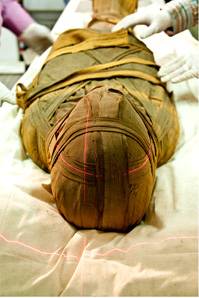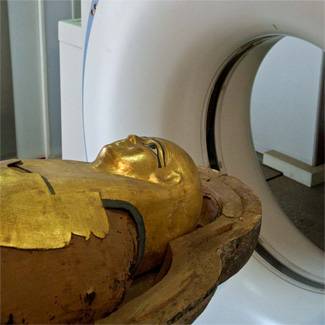CT scans of mummies show atherosclerosis common in ancient Egyptians
1 December 2009
A new study has found that atherosclerosis, hardening of the arteries, was common in ancient Egyptians, challenging a belief that vascular disease is a modern affliction caused by current-day risk factors such as stress and sedentary lifestyles.
A team of American and Egyptian researchers evaluated the prevalence of cardiovascular disease in 3,500-year-old mummies. Results were presented during the American Heart Associate 2009 Scientific Sessions and published simultaneously in the Journal of the American Medical Association.
“Our findings show that atherosclerosis is not strictly a disease of modern humans caused by unhealthy lifestyles,” said Michael Miyamoto, a cardiologist and co-investigator of the study. “In fact, it is possible that humans have a genetic predisposition to the development of atherosclerosis. Our findings remind us of the value of preventive medicine in eliminating or controlling manifestations of heart and vascular disease.”


The team carefully examined 22 mummies from the
Museum of Egyptian Antiquities using a six-slice CT scanner. Source: UC
San Diego School of Medicine
In 2009, Miyamoto and a team of cardiologists and Egyptologists, carefully examined 22 mummies from the Museum of Egyptian Antiquities using a six-slice CT scanner. In the mummies with identifiable arteries, more than half had calcifications in the walls of their arteries. Those who died after the age of 45 showed the highest degree of calcification. Vascular disease was observed in both male and female mummies.
“As the mummy CT images appeared on the monitor, we were struck by the fact that our project was made possible by combining the advanced technologies of two different eras — the science of mummification in ancient Egypt and modern imaging,” said Miyamoto. “In a real sense, this was a scientific collaboration that spanned great time and distance.”
The oldest mummified Egyptian exhibiting the greatest degree of atherosclerosis was Lady Rai. The nursemaid to Queen Ahmose Nefertiti, Lady Rai lived to an age between 30 and 40 years old circa 1530 BC. To put this in context, Lady Rai lived approximately 300 years prior to the time of Moses and two hundred years prior to King Tutankhamun.
Surprised by their results, the cardiologists asked the Egyptian preservation team to share information about the lifestyle of ancient Egypt. In general, all who were later mummified, served in the court of the Pharaoh or as priests or priestesses. Diet-wise, eating beef, duck and other poultry was not uncommon. Since refrigeration was unavailable, salt was widely used for meat preservation. Tobacco was not available and without mechanical transportation, they were likely physically active.
Collaborators in the study were Michael I. Miyamoto, MD, MS, UC San Diego; L. Samuel Wann, MD Wisconsin Heart Hosp; Randall C Thompson, MD, Mid America Heart Institute; Adel H Allam, MD, Al Azhar Medical School; Abd el-Halim Nur el-Din, PhD and Gomma Ab el-Maksoud, PhD, Cairo Univ; Ibrahem Badr, PhD, Institute of Restoration; Hany Abd el-Amer, Natl Res Ctr, Dokki; Jennifer J Thomas, Massachusetts General Hospital and Gregory S Thomas, UC Irvine.
This study was funded by Siemens Healthcare and the Bank of Egypt.